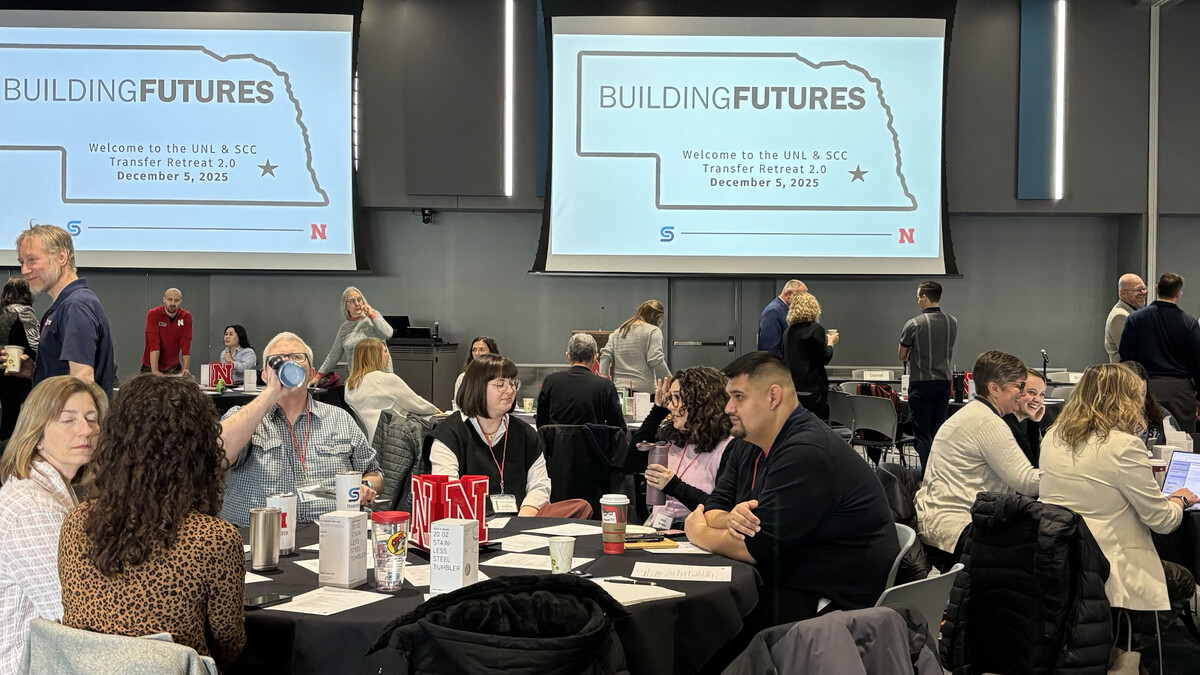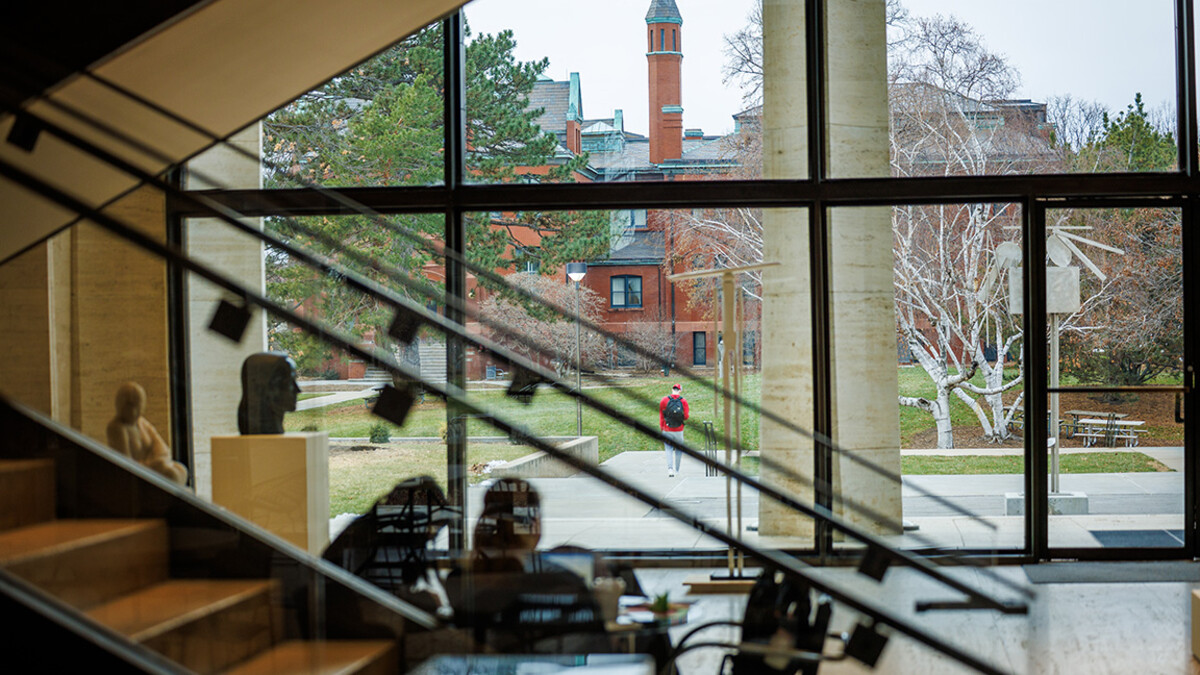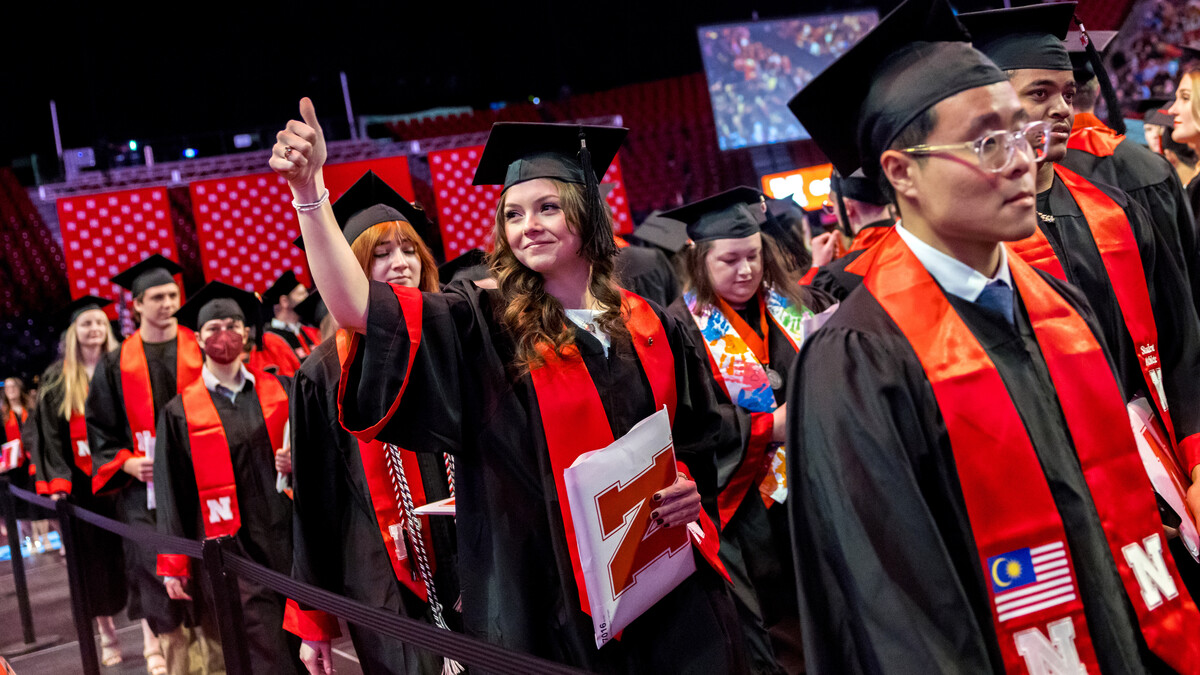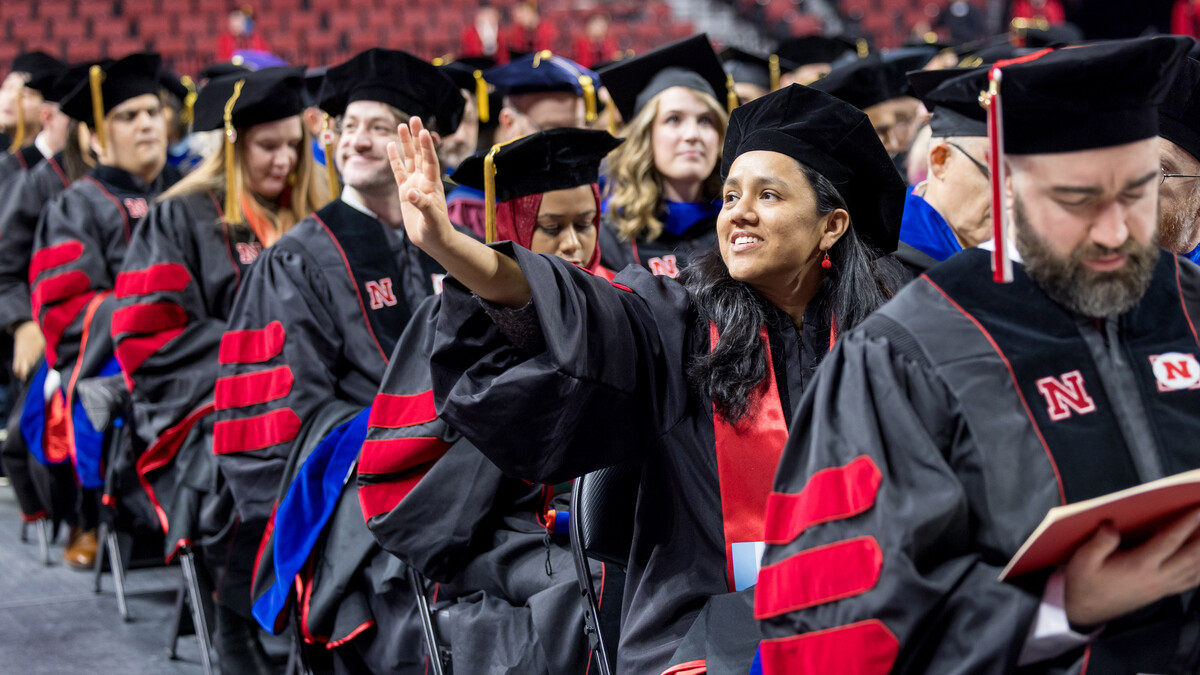
Liz McCue | University Communication and Marketing
Liz McCue | University Communication and Marketing
Kelli Boling (pictured), assistant professor of advertising and public relations at Nebraska, and Danielle Slakoff, associate professor of criminal justice at California State University, Sacramento, have published new research highlighting the impacts of true crime media on the family and friends of crime victims.
University of Nebraska–Lincoln faculty were interviewed about the renewed debate over conversion therapy and America’s fascination with true crime for national news stories in October. The stories were among 40-plus featuring Husker faculty, staff, students, administrators, centers and programs during the month.
- Kelsy Burke, professor of sociology, was quoted in an Oct. 7 New York Times article on the revived debate over conversion therapy for LGBTQ youth. “Conversion therapy had an image problem in that the messaging was about making someone straight, and that was losing appeal broadly in American culture,” she said. “But there’s this new moment when it comes to debates about transgender rights that is allowing conversion therapy to be back on the table.” (This article requires a subscription.)
- Kelli Boling, assistant professor of advertising and public relations at Nebraska, and Danielle Slakoff, associate professor of criminal justice at California State University, Sacramento, have published new research highlighting the impacts of true crime media on the family and friends of crime victims. Newsweek published an Oct. 10 article on the research. “There’s a horrible intrusiveness that's never going to go away, and often (the case is) going to be covered for the rest of their lives,” she said. “On the flip side, being available to media helps them find leads in certain cases, especially in missing person cases. It keeps people talking about the cases and sometimes helps them change the narrative and correct inaccuracies.”
- Boling also discussed the appeal of true crime as a guest on the Oct. 16 episode of WOSU’s “All Sides With Amy Juravich.” She noted that women were writing popular magazine articles about crime in the early 1800s and that mystery writer Agatha Christie is one of the highest-grossing novelists of all time. “People … like to see justice served. They like to solve a mystery,” she said. "I don’t know that it’s just true crime as much as it is we like to see something come to a complete ending; we like to solve that mystery.”
Additional national news coverage in October included:
- Research led by Jeffrey Stevens, psychology, founding director of Nebraska’s Canine Cognition and Human Interaction Lab, was highlighted in an Oct. 1 American Psychological Association article titled “How dogs think.” The lab is observing whether dogs act differently around odors collected from humans before and after a stressful task.
- Farm Journal published an Oct. 2 story on the Nebraska Elite 11 Veterinarian Program, a partnership between the State of Nebraska and the University of Nebraska–Lincoln aimed at addressing the state’s shortage of food animal veterinarians. Deb VanOverbeke, animal science, and Sydney Hutchinson, a junior animal science and pre-veterinary medicine student and Elite 11 scholarship recipient, were interviewed for the story.
- The university is accepting applications for the Elite 11 program, with a deadline of Feb. 2. Articles on the application announcement appeared in KHGI, the Norfolk Daily News, Brownfield Ag News and Tri-State Livestock News.
- Broadway World published an Oct. 2 story on the reimagined staging of William Shakespeare’s “Hamlet,” which played at the Lied Center for Performing Arts on Oct. 17. The production is a collaboration between Toronto dance company Côté Danse and multidisciplinary company Ex Machina.
- Shannon Sand, agricultural economics extension educator, offered tips for onboarding new farm workers in an Oct. 6 Successful Farming article. She said research shows having an onboarding process for employees increases productivity by more than 70% and retention by 82%.
- Silicon Prairie News published an Oct. 7 article on the new Frontier Tech Lab at Nebraska Innovation Studio. The first-of-its-kind collaborative prototyping hub is designed to give Nebraska innovators access to advanced manufacturing tools, engineering expertise and hands-on student support. John Strope, NIS program coordinator and the lab’s director; Adam Eakin, associate director of the University of Nebraska State Museum, which partnered with the lab; and Susan Weller, director of the NU State Museum, were interviewed for the article.
- Kyra Elliott, a graduate student in animal science at Nebraska, recently earned the 2025 Dr. Bobby VanStavern Award for Beef Quality Research from the American Meat Science Association, KHGI and Tri-State Livestock News reported. Elliott was recognized at the Reciprocal Meat Conference for her innovative work on predicting marbling in the ribeye, a crucial factor in beef quality grading.
- Silicon Prairie News published an Oct. 8 article on FindU, a startup founded by Husker juniors Kenny Morales and Wilson Overfield, both students in the Jeffrey S. Raikes School of Computer Science and Management. FindU, an app that aims to match high school students with their best-fit college, won the $10,000 grand prize in last year’s Silicon Prairie Startup Week Pitch Competition. Morales and Overfield said the victory helped validate their work and inspire them to keep building their company.
- The Nebraska News Map, led by Jessica Walsh, journalism, was highlighted in an Oct. 9 Midwest Newsroom article on the struggles of Iowa-based newspaper chain Lee Enterprises. The Nebraska News Map is the first-ever Nebraska local news interactive map and ecosystem report. Walsh was also interviewed for the article.
- A 2023 study by Kazi Albab Hussain, then a doctoral student at Nebraska, and colleagues found that microplastics are released in huge quantities from plastic containers when they’re microwaved. Hussain, now a postdoctoral research associate in civil and environmental engineering, was interviewed about the study for an Oct. 13 Washington Post article.
- The U.S. Drought Monitor — produced jointly by the university’s National Drought Mitigation Center, the National Oceanic and Atmospheric Administration and the U.S. Department of Agriculture — was cited in an Oct. 14 CBS News story on fall foliage colors being muted due to drought. More than 40% of the United States was considered to be in drought in early October, according to the monitor.
- New research led by Karrie Weber, biological sciences, warns of the dangers of nitrate and uranium interacting in groundwater, the source of much U.S. drinking water. The research was featured in an Oct. 14 Earth.com article.
- Amanda Barrett, a graduate student in educational psychology at Nebraska, was interviewed for an Oct. 15 Science News Explores article on a new study suggesting that stronger connections at school can help limit some of the harm from bullying. Barrett, who was not involved in the research, said she likes how the study emphasizes the social context of schools. “You can’t look at bullying as a finding in isolation,” she said.
- A recent article by Kyle Langvardt, associate professor of law at Nebraska, and Alan Rozenshtein, associate professor of law at the University of Minnesota, was featured in an Oct. 15 article in The Regulatory Review on online content moderation in the wake of Moody v. NetChoice (2024). The two argue that the “editorial discretion” doctrine under the First Amendment distorts discussions of whether and how policymakers can regulate online platforms and propose a new analytical framework.
- Gary Sullivan, animal science, was quoted in an Oct. 19 New York Times article on sausage casings. Animal intestines provided a ready-made way of holding sausage meat, he said. “We had these natural tubes,” he said.
- Fadi Alsaleem, interim chief technology officer for Grasshopper Health and associate professor in the Durham School of Architectural Engineering and Construction, was interviewed for Silicon Prairie News’ “Prairie Portraits” feature on Oct. 20. Grasshopper Health is a medical technology startup originating from collaborative work across the University of Nebraska system.
- Matt Stockton, agricultural economics, was interviewed for an Oct. 20 Tri-State Livestock News article on President Donald Trump considering an Argentinian beef deal to try to bring down prices in the United States. Stockton said such a deal could bring cattle and beef prices down, but how much was only speculation at the time. “It depends on how much beef we get and how fast it gets here,” he said.
- The University of Nebraska–Lincoln added 21 weather stations to the Nebraska Mesonet network this year through $1.48 million in funding from the U.S. Army Corps of Engineers, U.S. Department of Agriculture’s Farm Service Agency and Lower Loup and Upper Elkhorn Natural Resources Districts. Stories on the expansion appeared in KSNB, the Lincoln Journal Star, Nebraska Public Media, Rural Radio Network, The Fence Post and Tri-State Livestock News.
- Dirac Twidwell, agronomy and horticulture, was interviewed for an Oct. 21 segment on RFD-TV. He discussed the university’s efforts to combat woody encroachment in the Great Plains.
- Fifty-three percent of respondents to the 2025 Nebraska Rural Poll believe they are better off than they were five years ago, up from 36% last year. Similarly, 46% of respondents believe they will be better off 10 years from now, up from 34% last year. Stories on the latest batch of poll results appeared in KFXL, KHGI, the Nebraska City News-Press and Tri-State Livestock News.
- “Dog Man: The Musical,” based on the popular book series by Dav Pilkey, is coming to the Lied Center for Performing Arts at 4 p.m. Nov. 9. Broadway World published an Oct. 23 article on the show.
- Ross Secord, Earth and atmospheric sciences, was part of an international research team that recently found that dinosaurs were flourishing before a catastrophic asteroid strike 66 million years ago. The team also included researchers from Baylor University, New Mexico State University and The Smithsonian Institution. The research was originally published in the journal Science and picked up by numerous media outlets.
- A recent report shows that there were no observable negative effects on engine performance from using E30 gasoline on 50 vehicles in the State of Nebraska’s fleet, Ethanol Producer Magazine reported Oct. 24. The study was led by Rajib Saha, chemical and biomolecular engineering, alongside graduate researcher Adil Alsiyabi and undergraduate student Seth Stroh.
- A new butterfly species discovered by Husker researchers has been named after Iryna Zarutska, a Ukrainian refugee murdered on the Charlotte, North Carolina, light rail in August. The new species, Celastrina iryna, is a hybrid species that is similar to Celastrina neglecta but “differs in its unique dorsal overlay.” Stories on the new species appeared in The Queen City News (Charlotte), The Hill, Yahoo! News and several other media outlets.
- Anastasia Meyer, associate extension educator with Nebraska Extension, was quoted in an Oct. 27 Midwest Newsroom story on grain elevator operators expanding storage to hold this year’s surplus grain. She said elevators are vital to communities because they provide an economic benefit and help connect people at a time when many older, rural Americans feel isolated.
- Nathan Huynh, civil and environmental engineering, was interviewed for an Oct. 28 Reader’s Digest article on the regional differences among road terms and why they matter. Most of the United States uses the term “highway” or “expressway” for a high-speed road, except for California, which uses “freeway,” he said.
- Husker researchers Seunghee Kim, Karrie Weber and Hyun-Seob Song are studying the Midcontinent Rift — which runs from beneath Lake Superior through parts of Minnesota, Michigan, Wisconsin, Iowa, Nebraska and Kansas — to determine how best to access a potential store of natural hydrogen that could yield vast amounts of clean energy. The research was highlighted in an Oct. 29 Earth.com article. Weber was quoted in the article.
- Dr. Jeffrey P. Gold, president of the University of Nebraska system, and Tiffany Heng-Moss, interim Harlan Vice Chancellor for the Institute of Agriculture and Natural Resources and interim vice president for agriculture and natural resources for the NU system, co-wrote an Oct. 29 op-ed for Agri-Pulse titled “How Nebraska is leading the next revolution in precision ag.” “At the University of Nebraska–Lincoln, we aim to be relentlessly relevant, moving ag tech and precision and digital ag forward each day,” they wrote.
- Eric Thompson, economics, director of the university’s Bureau of Business Research, was interviewed for an Oct. 30 Midwest Newsroom story on job prospects for recent college graduates. He cautioned against worrying too much about recent fluctuations in recent graduates’ employment rates, as that population tends to be at the most disruptive part of their lives.
Faculty, administration, student and staff appearances in the national media are logged at http://newsroom.unl.edu/inthenews. If you have additions to the list, contact Sean Hagewood at shagewood2@unl.edu or 402-472-8514. If you have suggestions for national news stories, contact Leslie Reed at lreed5@unl.edu or 402-472-2059.







